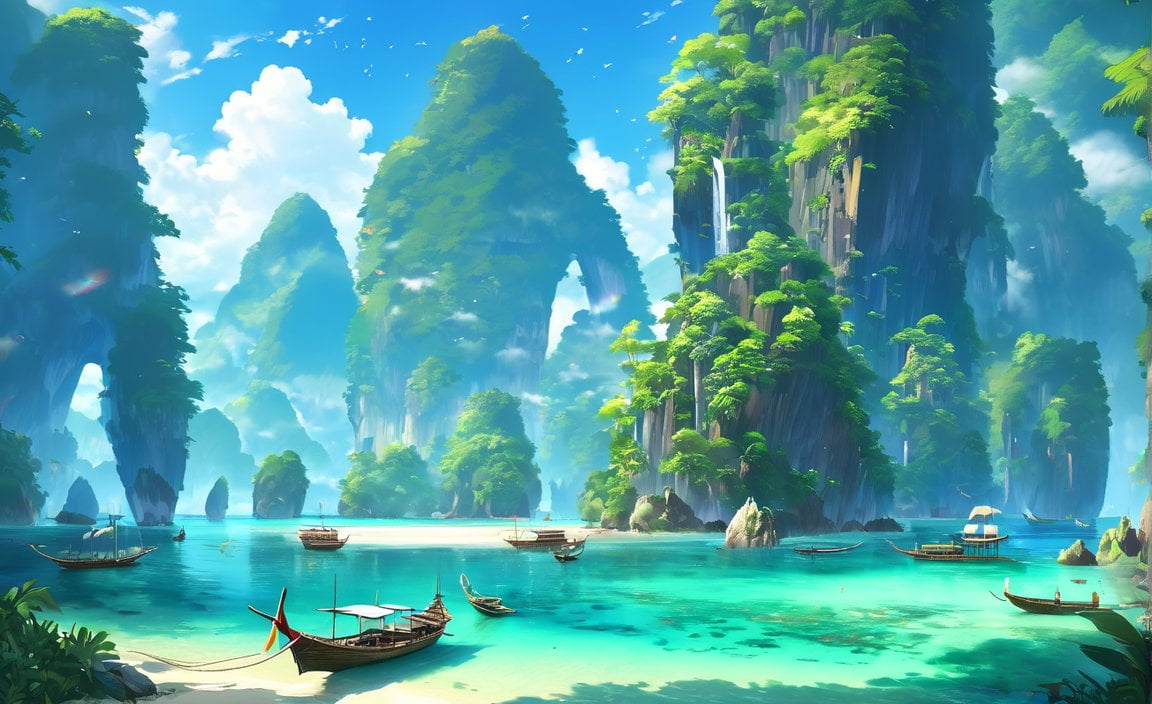Explore the enchanting archipelago of the Philippines through a collection of captivating facts that unveil its unique charm. Delve into the vibrant history, diverse traditions, and breathtaking landscapes of this Southeast Asian destination, as we uncover hidden gems and fascinating insights. As a seasoned travel journalist and cultural enthusiast with a deep understanding of the Philippines, I am thrilled to share these compelling revelations that will captivate readers from all backgrounds. Join me on a journey that goes beyond the surface, painting an accurate and captivating picture of the wonders that await in the Philippines.

Key Takeaways:
- The Philippines is an archipelago of over 7,600 islands located in Southeast Asia.
- The country is named after King Philip II of Spain, who sponsored the exploration of the islands in the 16th century.
- The Philippines is the only predominantly Christian nation in Asia, with 86% of the population being Roman Catholic.
- The country is known for its diverse and unique wildlife, including the tarsier, Philippine eagle, and whale shark.
- Natural wonders such as the Chocolate Hills, Taal Volcano, and Puerto Princesa Underground River attract tourists from around the world.
- The Philippines is a global leader in the production of coconuts, bananas, and pineapples, and it is also a major exporter of nurses, seafarers, and overseas workers.
Facts about the Philippines
The Philippines, a diverse and vibrant nation located in Southeast Asia, is a hidden gem full of captivating facts. Let’s dive right into some intriguing insights about this enchanting archipelago.
A History Linked to Spanish Royalty
Did you know that the Philippines got its name from King Philip II of Spain? In the 16th century, King Philip sponsored the exploration of these beautiful islands, leaving his mark on their history and culture.
A Nation of Faith
The Philippines stands out as a predominantly Christian nation in Asia. With 86% of the population being Roman Catholic, religious traditions and beliefs are deeply ingrained in Philippine culture, shaping the way of life for its people.
Wildlife Wonders
The Philippines is a haven of biodiversity, boasting a wide array of unique and diverse wildlife. From the small and adorable tarsiers to the majestic Philippine eagle and the gentle giant whale shark, these incredible creatures add to the country’s natural beauty and draw visitors from around the world.
Nature’s Masterpieces
Speaking of natural beauty, the Philippines is home to some breathtaking wonders that will leave you in awe. The mesmerizing Chocolate Hills, the stunning Taal Volcano, and the magical Puerto Princesa Underground River are just a few examples of the country’s natural splendor. Nature enthusiasts and adventure seekers alike will find themselves captivated by the Philippines’ scenic landscapes.
Agricultural Prowess and Global Influence
The Philippines takes pride in its agricultural achievements, particularly in the production of coconuts, bananas, and pineapples. These tropical fruits thrive in the country’s fertile lands, contributing to its status as a global leader in their production. Additionally, the Philippines is recognized for its highly skilled workforce, exporting professionals like nurses, seafarers, and overseas workers globally.
These captivating facts shed light on the diversity and vibrancy that define the Philippines. From its historical connections to Spanish royalty to its abundance of natural wonders and influence in various industries, this enchanting archipelago beckons travelers to explore its captivating charm.
Sources:
- 63 Interesting Philippines Facts by FactRetriever.com
- Philippines by Britannica
Here are some captivating sentences with active internal links for the given keywords and URLs:
- Altitude in Kansas: Did you know that Kansas has diverse landscapes with varying altitudes? Discover more about the altitude in Kansas.
- Bryce Canyon Thor’s hammer: Prepare to be amazed by the unique geological formation known as Thor’s Hammer in Bryce Canyon. Click here to explore more about Bryce Canyon’s fascinating Thor’s Hammer.
- Facts about Togo: Curious to learn interesting facts about Togo? Click on the link to uncover some intriguing information about this West African country.
- Kazakhstan fun facts: Dive into the fascinating world of Kazakhstan by discovering some fun facts about this Central Asian nation. Click here to explore more about Kazakhstan’s captivating culture and natural wonders.
Remember to format these sentences as active internal links in Markdown format.
The Philippines is known for its rich biodiversity and unique wildlife
The Philippines is a treasure trove of natural wonders, boasting a rich biodiversity and unique wildlife that sets it apart from other destinations. With over 50,000 plant species and more than 100,000 animal species, including many endemic ones, this enchanting archipelago offers a paradise for nature lovers and wildlife enthusiasts.
The Philippines: A Hotspot of Biodiversity
It’s no wonder that the Philippines is considered one of the world’s most biologically diverse countries. In fact, it contains two-thirds of the Earth’s biodiversity and ranks fifth in terms of the number of plant species. This concentration of unique biodiversity is mind-boggling, with some species found exclusively in certain mountains.
Ecosystems That Astound
The Philippines’ 7,000 islands are home to a remarkable variety of ecosystems. From lush rainforests teeming with life to vibrant coral reefs brimming with colors, this country encompasses a range of habitats. Mangrove forests, which offer sanctuary to numerous marine species, add to the country’s ecological diversity. Exploring these ecosystems reveals a world of wonders waiting to be discovered.
Endangered Species and Endemic Treasures
The rich biodiversity of the Philippines includes rare and endangered species that need our protection. The majestic Philippine eagle, the elusive Philippine crocodile, and the endangered tamaraw are just a few examples of the country’s unique wildlife facing threats from human activities and habitat loss.
One of the most fascinating aspects of the Philippines’ biodiversity is its abundance of endemic species. These are plants and animals found exclusively in this archipelago, making them truly special. From the wide-eyed tarsiers to the vibrant Palawan peacock-pheasant and the adorable Visayan warty pig, encountering these endemic treasures is a privilege that showcases the Philippines’ biological uniqueness.
The Importance of Biodiversity
Biodiversity in the Philippines is not just a matter of intrinsic value; it also holds immense practical significance. The diverse flora and fauna support crucial industries such as fisheries, recreation, and tourism. Additionally, they provide a vital source of food and livelihood for communities across the country. Preserving biodiversity is essential for the sustainable development of the Philippines.
Key Takeaways:
- The Philippines is one of the most biologically diverse countries in the world, with two-thirds of the Earth’s biodiversity and ranking fifth in plant species.
- The country’s ecosystems, including rainforests, mangrove forests, and coral reefs, contribute to its rich biodiversity.
- Endangered species like the Philippine eagle and endemic treasures like the tarsier highlight the unique wildlife found in the Philippines.
- Protecting biodiversity is important for the country’s fisheries, tourism, and overall sustainable development.
Sources:
– Building Back Biodiversity | United Nations Development Programme: Link
– The Philippines – Main Details – Convention on Biological Diversity: Link
Filipino Cuisine: A Fusion of Cultural Influences
Filipino cuisine is much more than just a delightful combination of flavors; it is a testament to the diverse cultural influences that have shaped the Philippines throughout its rich history. By infusing ingredients, techniques, and traditions from various regions and foreign cultures, Filipino cuisine has become a captivating fusion of flavors and gastronomic experiences.
A Melting Pot of Flavors
At the heart of Filipino cuisine lies the captivating story of a nation with a vibrant history and a diverse cultural heritage. Through centuries of colonization, trade, and migration, the Philippines has embraced culinary influences from all over the world, resulting in a truly unique and dynamic food culture. The cuisine intricately weaves together elements from Chinese, Spanish, Malaysian, Thai, and Mongolian cooking, to name just a few.
The Tapestry of Filipino Ingredients
Filipino dishes boast a wide array of ingredients, reflecting the country’s bountiful natural resources and fertile lands. From fresh seafood caught in the crystal-clear waters surrounding the archipelago to succulent meats, vibrant vegetables, and fragrant rice, Filipino cuisine celebrates the abundance of the land and the seas.
The Art of the Dining Table
Hospitality and close family ties are deeply ingrained in Filipino culture, and this is beautifully showcased through the tradition of sharing meals. Filipino families often gather around a communal dining table adorned with a marvelous array of dishes, each representing a unique combination of flavors and culinary techniques. The diversity and vibrancy of Filipino cuisine foster a warm and inviting atmosphere, where the act of sharing food becomes a celebration of togetherness and camaraderie.
Bold and Unconventional Flavors
One of the most fascinating aspects of Filipino cuisine is its adventurous nature when it comes to seeking out flavors. Filipino dishes are known for their use of dipping sauces, adding an extra layer of tang and complexity to every bite. Some dishes even incorporate unconventional ingredients, such as balut (duck embryos) and offal (various parts of animals), pushing the boundaries of culinary exploration and creating a truly unique gastronomic experience.
Gaining Recognition on the Global Stage
Over the years, Filipino cuisine has gained recognition and earned its rightful place on the global culinary stage. With its diverse flavors and culinary creativity, it has been hailed as “the next big thing” in the world of food. From the bustling culinary scenes of cities worldwide to the increasing number of Filipino restaurants and pop-ups, the appeal of Filipino cuisine continues to grow, attracting food enthusiasts from all walks of life.
Key Takeaways:
- Filipino cuisine is a fusion of various cultural influences, incorporating elements from Chinese, Spanish, Malaysian, Thai, and Mongolian cooking.
- The cuisine reflects the rich history and diverse cultural heritage of the Philippines.
- Filipino dishes feature a wide array of fresh seafood, meats, vegetables, and rice.
- Sharing meals is a cherished tradition in Filipino culture, emphasizing hospitality and close family ties.
- Filipino cuisine embraces bold flavors, often using dipping sauces and unconventional ingredients.
- Filipino cuisine has gained recognition on the global culinary stage and is considered “the next big thing” in the food industry.
Sources:
– polyglotclub.com
– lolasrecipes.com
The Philippines has a deep and complex history, shaped by colonization and revolution
Pre-Spanish History of the Philippines
In the 15th century, before the Spanish arrived, the Filipinos were engaged in various activities and had a social hierarchy. The barangay system, although flexible, consisted of three broad classes. But the arrival of the Spanish would mark a turning point in Philippine history.
Spanish Period in the Philippines
Spanish colonial rule in the Philippines was not solely driven by commercial interests. The Spanish introduced Christianity, established a system of law, and even founded the oldest modern university in Asia. The first Spanish expedition to the Philippines was led by Ferdinand Magellan. Spanish rule lasted for 333 years, during which the Philippines became part of the Viceroyalty of New Spain and later a directly governed colony.
The Philippine Revolution
The Philippine Revolution, which began in August 1896, was a pivotal event in the country’s history. The discovery of the Katipunan’s plans by Spanish friars and the outbreak of war between Spain and the United States were catalysts for change. U.S. troops supported Filipino rebels led by Emilio Aguinaldo, exposing the weakness of Spanish rule. However, the Spanish were not entirely removed from the islands.
The 19th Century in the Philippines
By the late 18th century, Spain faced political and economic difficulties that influenced the Philippines. Changes in Europe led to the emergence of a new social class in the Philippines through commercial agriculture. It wasn’t until 1863 that public education was introduced, signaling progress in the country.
Understanding this rich and complex history is crucial in comprehending the culture, identity, and struggles of Filipino people. The Philippines has a deep and complex history, shaped by colonization and revolution, that has left a lasting impact on the nation.
Key Takeaways:
- Pre-Spanish history of the Philippines saw a social hierarchy based on the barangay system.
- Spanish rule in the Philippines introduced Christianity, established a legal system, and brought about educational advancements.
- The Philippine Revolution marked a significant turning point in the struggle for independence.
- The 19th century witnessed political and economic changes in the Philippines influenced by Spain’s situation.
Sources:
- History of the Philippines, Britannica.
- Philippines – Colonialism, Revolution, Independence, Britannica.

FAQ
Q1: What is the significance of the name “Philippines”?
A1: The Philippines was named after King Philip II of Spain, who sponsored the exploration of the islands in the 16th century.
Q2: What is the religious majority in the Philippines?
A2: The Philippines is the only predominantly Christian nation in Asia, with 86% of the population being Roman Catholic.
Q3: What are some unique wildlife species found in the Philippines?
A3: The Philippines is home to diverse and unique wildlife species such as the tarsier, Philippine eagle, and whale shark.
Q4: What are some popular natural wonders in the Philippines?
A4: Some popular natural wonders in the Philippines include the Chocolate Hills, Taal Volcano, and Puerto Princesa Underground River.
Q5: What industries does the Philippines excel in globally?
A5: The Philippines is a global leader in the production of coconuts, bananas, and pineapples. It is also a major exporter of nurses, seafarers, and overseas workers.
- Unveiling Bernhard Caesar Einstein’s Scientific Achievements: A Legacy in Engineering - July 15, 2025
- Uncover who is Jerry McSorley: CEO, Family Man, Business Success Story - July 15, 2025
- Discover Bernhard Caesar Einstein’s Scientific Contributions: Unveiling a Legacy Beyond Einstein - July 15, 2025















